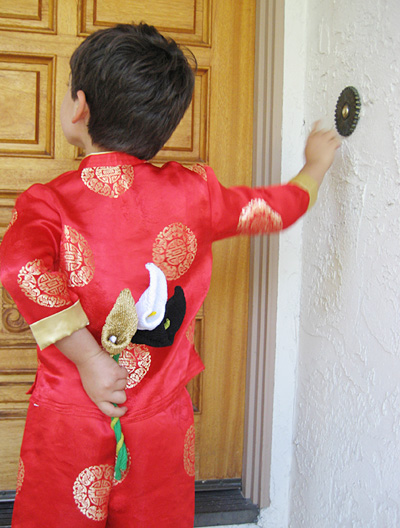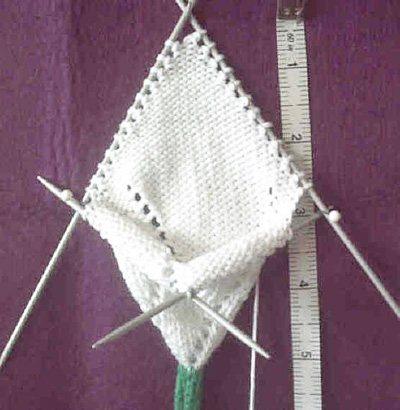
 Stem
Stem
Using CC2, CO 4 sts.
Work I-Cord for 12 inches, or to desired length.
Next Row: [K1, kfb] twice. 6 sts.
Blossom
Next Round: Using MC, k all sts,
knitting 2 sts onto each of 3 needles. Break
CC2, leaving a 6-inch tail.
K 1 round more.
Shape Outer Blossom:
Round 1: [YO, k to end of needle] 3
times. 3 sts increased.
Round 2: K all sts.
Repeat these 2 rounds 13 times more. 48 sts;
16 sts on each needle.
Shape Point
Note: When working the short rows that follow,
do not wrap stitches at turning points; simply turn
the work. The turning points will form the edges
of the triangular portion of the blossom, once Outer
and Inner blossom portions have been turned and
joined.
Row 1 [RS]: K36, turn.
Row 2 [WS: P23, turn.
Row 3 [RS]: K22, turn.
Row 4 [WS: P21, turn.
 Row
5 [RS]: K20, turn.
Row
5 [RS]: K20, turn.
Row 6 [WS: P19, turn.
Row 7 [RS]: K18, turn.
Row 8 [WS: P17, turn.
Row 9 [RS]: K16, turn.
Row 10 [WS: P15, turn.
Row 11 [RS]: K14, turn.
Row 12 [WS: P13, turn.
Row 13 [RS]: K12, turn.
Row 14 [WS: P11, turn.
Row 15 [RS]: K10, turn.
Row 16 [WS: P9, turn.
Row 17 [RS]: K8, turn.
Row 18 [WS: P7, turn.
Row 19 [RS]: K6, turn.
Row 20 [WS: P5, turn.
Row 21 [RS]: K4, turn.
Row 22 [WS: P3, turn.
Row 23 [RS]: K2, turn.
Row 24 [WS: P1, turn.
Row 25 [RS]: K1, turn.
Row 26 [WS: P2, turn.
Row 27 [RS]: K3, turn.
Row 28 [WS: P4, turn.
Row 29 [RS]: K5, turn.
Row 30 [WS]: P6, turn.
Row 31 [RS]: K7, turn.
Row 32 [WS]: P8, turn.
Row 33 [RS]: K9, turn.
Row 34 [WS]: P10, turn.
Row 35 [RS]: K11, turn.
Row 36 [WS]: P12, turn.
Row 37 [RS]: K13, turn.
Row 38 [WS]: P14, turn.
Row 39 [RS]: K15, turn.
Row 40 [WS]: P16, turn.
Row 41 [RS]: K17, turn.
Row 42 [WS]: P18, turn.
Row 43 [RS]:K19, turn.
Row 44 [WS]: P20, turn.
Row 45 [RS]: K21, turn.
Row 46 [WS]: P22, turn.
Row 47 [RS]: K23, turn.
Row 48 [WS]: P24, turn.
Row 49 [RS]: K36.
Short rows are complete; resume working in
the round.
Shape Inner Blossom:
Round 1: [Ssk, k to end of needle] 3 times.
3 sts decreased.
Round 2: K all sts.
Repeat these 2 rounds 13 times more. 6 sts remain.
Stamen
Next Row: Using CC1, work all sts onto one
needle as follows: [ssk, k1] twice. 4 sts.
Break MC, leaving a 6-inch tail.
Work 1 inch in I-Cord.
Next I-Cord Row: Ssk, k2. 3 sts.
Next I-Cord Row: S2KP. 1 st.
Break yarn, leaving a 6-inch tail; draw tail through
last st and pull tight.

